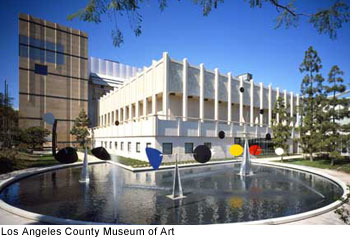Film at LACMA ready for its close-up
April 7, 2011
 It’s been a real nail-biter for fans of LACMA’s beleaguered classic film program, but it looks like this saga may have a Hollywood ending after all.
It’s been a real nail-biter for fans of LACMA’s beleaguered classic film program, but it looks like this saga may have a Hollywood ending after all.
Not the cavalry, but Film Independent and the New York Times are riding to the rescue, and in true cliffhanger fashion, just in the nick of time.
This could be the start of a beautiful friendship, with Film Independent handling the film programming side of things and the New York Times underwriting the effort. The new arrangement comes as the museum’s film program has struggled in recent years to find its financial footing and build an audience.
Both organizations bring a lot to the table. L.A.-based Film Independent is the non-profit arts organization that produces the Spirit Awards and the Los Angeles Film Festival. LACMA’s tapping the outfit for its programming and curatorial expertise, its marketing and audience-building acumen, and its ties to prominent cutting-edge filmmakers (Film Independent’s president is Bill Condon, director of “Gods and Monsters” and “Kinsey;” its board members include actors Laura Dern, Forest Whitaker and Don Cheadle.)
Plans call for Film Independent’s programming department and a new lead programmer, yet to be named, to work with LACMA’s director and curatorial staff to assemble film series that both showcase artistic achievement and contribute to the cultural conversation about movies.
And, as the sole presenting sponsor of LACMA’s new Film Series, the New York Times will be bringing the national newspaper’s heft and prestige to the project while increasing the paper’s visibility in the world’s film capital.
Speaking by phone from London, Michael Govan, LACMA’s chief executive, explained that the Film Independent-New York Times partnership will be starting out as a one-year commitment, but that Film Independent already is busy developing a 3-to-5-year plan. “It’s been happening pretty quickly,” Govan said. “We’d been doing our analysis and looking at what we should be doing moving into the future. We’d talked to Film Independent early in the beginning, and lately we kind of circled around again and decided they were the perfect choice.”
Govan said the arrangement is “open-ended.” “The idea is to grow the program,” he said, adding that the New York Times has signaled its interest in expanding its initial first-year commitment into a longer relationship.
LACMA’s new partnership is effective immediately. Look for some new programming in September, set to include a wide variety of offerings including dramatic features and documentaries; rarities from the archives; themed series showcasing particular artists; conversations with filmmakers; international showcases; family films; and special guest-curated programs. LACMA is also laying plans for monthly post-screening receptions to create a salon-like setting in which aficionados, artists and the general public can mix and mingle.
LACMA’s current consulting curator in the Film Department, Ian Birnie, is moving on, but patrons will soon enjoy his final series for LACMA, a Tim Burton summer film festival offered in conjunction with a major exhibition and retrospective of Burton’s dark and droll art, sculpture and production design work that opens May 29.
The museum’s popular Tuesday film matinees and individual film programs keyed to special exhibitions will continue.
The new partnership comes as LACMA prepares to host an expanded version of a traveling exhibition and film festival, currently showing in Paris at the Cinémathèque Français, featuring the works of Stanley Kubrick, whose works ranging from “Dr. Strangelove” to “A Clockwork Orange” are widely considered among the most influential in the history of cinema.
LACMA’s longer-range film programming plans are gradually coming into focus. Govan’s goal is to develop “a larger footprint for film” at the museum, in which screenings and exhibitions are at the center of a rotating galaxy of related curatorial, scholarly and social activities.
The new venture situates LACMA in the heart of L.A.’s cultural scene, but as part of an ensemble, not as a soloist. “We’ve been thinking about it a lot, that as times have gotten tougher, non-profit organizations should be doing more collaboration, “ Govan said, calling it “ a viable and exciting strategy in a time when resources for the arts are shrinking.”
Posted 4/7/11














 405 bridge work causes a stink
405 bridge work causes a stink